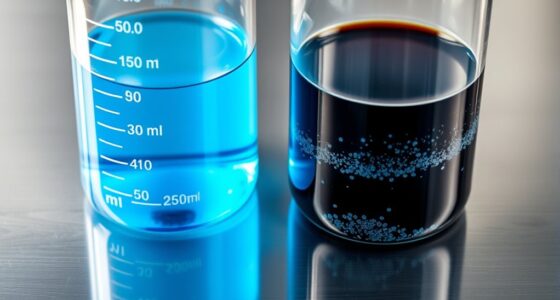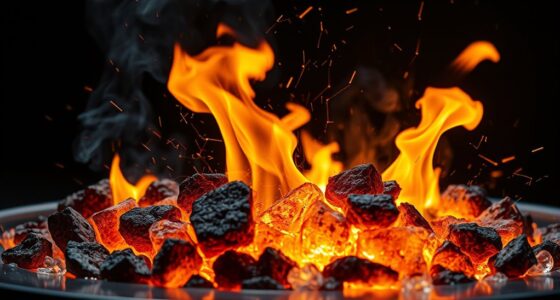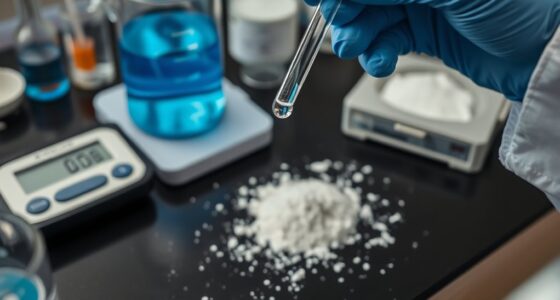Redox reactions are the key process that powers batteries and makes bleach effective. They involve electrons moving from one substance to another, causing oxidation and reduction. This transfer of electrons releases energy in batteries or breaks down stains in bleach. Understanding how items change their oxidation states reveals how these reactions work. If you want to discover how these reactions harness energy and cleaning power, there’s more to uncover about their fascinating chemistry.
Key Takeaways
- Redox reactions involve electron transfer, powering batteries and enabling chemical changes in products like bleach.
- Oxidation involves losing electrons, while reduction involves gaining electrons, driving energy flow in devices.
- Batteries generate electricity through controlled redox processes between electrode materials.
- Bleach oxidizes organic molecules by changing oxidation states, breaking down stains and germs.
- Understanding redox chemistry helps improve energy storage, corrosion prevention, and cleaning technologies.

Have you ever wondered how batteries generate power or why metals corrode? At the core of these processes lies the fascinating world of redox reactions, where electron transfer plays a pivotal role. Understanding how electrons move from one substance to another helps explain many common phenomena, from the functioning of your smartphone battery to the rusting of iron.
Redox reactions involve electron transfer, powering batteries, causing corrosion, and enabling cleaning processes through oxidation and reduction.
When a redox reaction occurs, one substance loses electrons, becoming oxidized, while another gains those electrons, becoming reduced. These paired processes are inseparable because electrons can’t just appear or disappear; they must be transferred from one species to another. This electron transfer is what creates the flow of electrical energy in a battery and drives chemical changes in corrosion or cleaning agents like bleach.
To grasp the mechanics of redox reactions, you need to consider oxidation states—numbers assigned to atoms within molecules that indicate their degree of oxidation or reduction. These states are a kind of bookkeeping system, helping you track what’s happening during the reaction. Recognizing how oxidation states change is also essential for understanding the energy transfer involved in these processes, which is vital for developing efficient energy storage devices like rechargeable batteries.
For example, in a simple reaction involving zinc and copper ions, zinc starts with an oxidation state of zero, while copper ions have an oxidation state of +2. As the reaction proceeds, zinc loses two electrons, lowering its oxidation state from zero to +2, and becomes oxidized. Simultaneously, copper ions gain those electrons, reducing their oxidation state from +2 to zero, and become metallic copper.
This transfer of electrons from zinc to copper illustrates the core principle of redox reactions: oxidation involves electron loss, and reduction involves electron gain. The changes in oxidation states aren’t just academic; they tell you which substances are oxidized and which are reduced in a reaction.
This understanding is essential for designing batteries, where controlled redox processes generate a flow of electrons through an external circuit, powering your devices. In corrosion, metals are oxidized, losing electrons and forming rust or other compounds.
Conversely, in bleach, redox chemistry breaks down stains and germs by oxidizing organic molecules, often involving chlorine species changing oxidation states. Recognizing how oxidation states shift during these reactions makes it easier to predict outcomes and manipulate these processes for your benefit.
Additionally, the concept of highly efficient energy transfer in redox reactions underpins many technological advancements, including fuel cells and rechargeable batteries. Recognizing how oxidation states shift during these reactions makes it easier to predict outcomes and manipulate these processes for your benefit.
In essence, redox reactions are about electron transfer, driven by changes in oxidation states. These reactions underpin many chemical and biological systems, powering your gadgets, protecting your metals, and cleaning your home.
Frequently Asked Questions
How Do Redox Reactions Influence Environmental Pollution Levels?
Redox reactions substantially influence environmental pollution levels by enabling pollution control methods. You can use oxidation reduction processes to treat wastewater, neutralize harmful chemicals, and reduce pollutants in air emissions.
Can Redox Reactions Be Used to Generate Renewable Energy?
You can use redox reactions to generate renewable energy by harnessing technologies like solar cells and bioenergy generation. Solar cells convert sunlight into electrical energy through redox processes.
Bioenergy involves bacteria or plants undergoing redox reactions to produce fuel. These methods allow you to produce clean, sustainable power, reducing reliance on fossil fuels.
What Role Do Redox Reactions Play in Biological Systems?
You should know that redox reactions are crucial in biological systems because they facilitate electron transfer during metabolic pathways. These reactions help your body produce energy by moving electrons through processes like cellular respiration.
When you breathe, oxygen accepts electrons, allowing your cells to generate ATP. Without redox reactions, your body’s energy production and metabolic functions would halt, highlighting their essential role in maintaining life.
Are Redox Reactions Reversible or Irreversible in Practical Applications?
You might think all redox reactions are either permanently irreversible or perfectly reversible, but that’s not always true. In practical applications, many involve controlled electron transfer where some reactions are reversible, allowing for reuse or regeneration, like in batteries.
Others are irreversible, such as in bleaching, where the reaction completes and can’t go back. Reaction reversibility depends on factors like energy barriers and reaction conditions, shaping their practical use.
How Can Redox Reactions Be Controlled in Industrial Processes?
You can control redox reactions in industrial processes through catalyst optimization and process regulation. By adjusting catalysts, you speed up or slow down specific reactions, ensuring efficiency and safety.
Implementing process regulation, like controlling temperature, pressure, and reactant flow, helps maintain desired reaction pathways and prevents unwanted side reactions. These strategies allow precise management of redox reactions, making industrial applications more effective, safe, and sustainable.
Conclusion
Now that you understand how redox reactions are the secret superpowers behind batteries and bleach, you’re truly unleashing nature’s most electrifying force. These reactions drive the energy that powers your gadgets and keeps your world bright and clean. Without them, life would be duller than a black hole. So next time you use a battery or clean with bleach, remember—you’re harnessing the incredible, unstoppable power of redox reactions. They’re the real superheroes behind everyday miracles!









